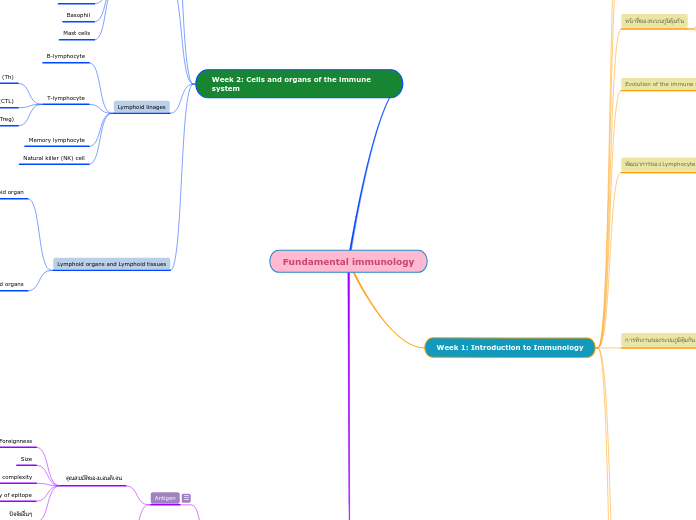Fundamental immunology
Week 1: Introduction to Immunology
Immunology
คือ การศึกษาเกี่ยวกับการตอบสนองทางภูมิคุ้มกัน ที่
เกี่ยวกับเซลล์และโมเลกุลต่างๆ ต่อจุลชีพและสิ่งแปลกปลอม
องค์ประกอบของระบบภูมิคุ้มกัน
ด่านป้องกัน (Barrier)
เซลล์ (Immune cells)
สารน้ำ
(Humoral substance)
อวัยวะ (Organs)
เนื้อเยื่อ (Lymphoid tissue)
หน้าที่ของระบบภูมิคุ้มกัน
Defense
Surveillance
Homeostasis
Evolution of the immune system
Phylogeny
ระบบภูมิคุ้มกันมีวิวัฒนาการมาตามลำดับ ตั้งแต่สัตว์ชั้นต่ำจนถึงสัตว์ชั้นสูง
สัตว์ไม่มีกระดูกสันหลัง
สัตว์มีกระดูกสันหลัง
พัฒนาการของ Lymphocyte
1.common lymphoid progenitor
2.rearrangement
3.selection process
4.progenitor, committed cells
5.maturation
การทำงานของระบบภูมิคุ้มกัน
1.Self and Non-Self discrimination
2.ระบบภูมิคุ้มกันเป็นการทำงานร่วมกันของ innateและ adaptive immune system ไม่สามารถแยกออกจากกันได้
3.เซลล์ในระบบภูมิคุ้มกันทั้ง Innate immunity และ Adaptive immunity ต้องอาศัย Receptor
innate immunity
Toll like receptor (TLR)
Scavenger receptor
Manose receptor
(MR)
Dectin
adaptive immunity
T cell receptor (TCR)
B cell recptor (BCR)
4.Diversity and Gene rearangement
5.Clone and clonal selection
6.ความจำ (Memory)
7.Immune regultion
Innate immunity และ adaptive immunity
1. Innate Immunity
Barrier
Phagocytic cells
Natural killer (NK) cells
Dendritic cell
Humoral substance
Complement
Aacute phase protein
Cytokine and Interferon
2. Adaptive Immunity
1.ไม่ทำปฏิกิริยากับแอนติเจนของตัวเอง (Non reactivity to self)
2.มีความจำเพาะ (Specificity)
3.มีการจดจำา (Memory)
4.มีความหลากหลาย (Diversity)
5.มีการปรับเปลี่ยนการตอบสนองไปตามชนิดของแอนติเจน (Adaptiveness or Specialization)
6.มีการควบคุมปริมาณการตอบสนอง (Self limitation/Cotraction and Homeostasis)
7.มีการแบ่งตัวเพิ่มจำนวนของ lymphocyte (Clonal expansion)
ชนิดของภูมิคุ้มกันแบบจำเพาะ (Type of adaptive immune response)
1. ภูมิคุ้มกันด้านสารน้ำ (Humoral immune response; HIR)
ประกอบด้วย แอนติบอดี
ที่สร้างจาก B- lymphocytes
2. ภูมิคุ้มกันชนิดพึ่งเซลล์ (Cell-mediated immune response; CMIR) หรือ Cellular immunity
ประกอบด้วยการทำงานของเม็ดเลือดขาวชนิด T-lymphocytes
Cytotoxic T lymphocyte (CTLs)
T helper (Th) cells
Week 2: Cells and organs of the immune system
Hematopoiesis
Extramedullary hematopoiesis
Intramedullary hematopoiesis
ขั้นตอนการสร้างเม็ดเลือด
Proliferation
Maturation
Differentiation
Myeloid lineage
Phagocytic cell
Neutrophil
Mononuclear phagocytes
monocyte
Macrophage
Dendritic cells
Eosinophil
Basophil
Mast cells
Lymphoid linages
B-lymphocyte
T-lymphocyte
Helper T- lymphocyte (Th)
T cytotoxic
lymphocyte (CTL)
Regulatory T lymphocyte (Treg)
Memory lymphocyte
Natural killer (NK) cell
Lymphoid organs and Lymphoid tissues
1. Primary lymphoid organ
Bone marrow
Thymus
2. Secondary lymphoid organs
Spleen
Red pulp
White pulp
Lymph node and lymphatic system
Mucosal immune system
Mucosal-Associated lymphoid tissue (MALT)
ทอนซิล (Tonsil) และต่อมอดีนอยด์ (Adenoid)
Peyer’s patches
Cutaneous Immune system
Cutaneous associated lymphoid tissue
Week 1: Immunostimulator
Antigen
คุณสมบัติของแอนติเจน
Foreignness
Size
Chemical complexity
structure and accessibility of epitope
ปัจจัยอื่นๆ
ชนิดของแอนติเจน
T - independent Antigen
T -dependent Antigen
immunogen
มีลักษณะสำคัญ 2 ประการ
1. Immunogenicity
2. Specific reaction (Antigenicity)
Hapten
Epitope หรือ Antigenic Determinant
1.Conformational determinant
2.Linear determinant
3.Neoantigenic determinant
Superantigens
Adjuvants
Mitogen
